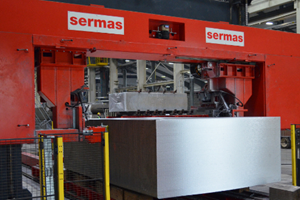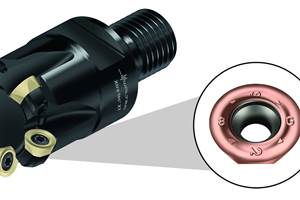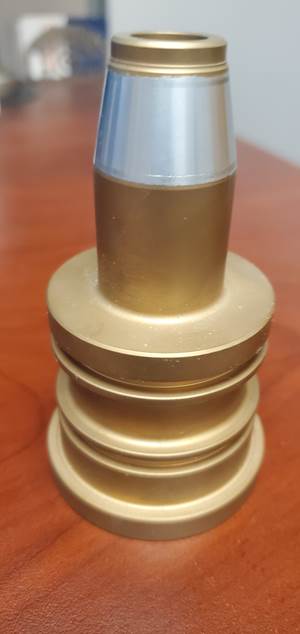Safety in the Mold Shop
I was standing 50 feet from the toolroom door and I could hear the sound of someone trying to remove a stubborn leader pin from a mold plate - or laying train tracks
I was standing 50 feet from the toolroom door and I could hear the sound of someone trying to remove a stubborn leader pin from a mold plate - or laying train tracks. I have done this a few times myself using short, controlled blows from a large, 35-pound brass hammer with the plate laying flat on the table - and if you don't get cheap with the penetrating oil they are usually driven right out. However, it is safer to use an arbor press for this job. Then, you don't run the risk of swelling the end of the pin or damaging the plate, which further complicates the job. It's just that the set-up is more time-consuming. Decisions, decisions...
I have been building things since I was able to reach the tools on my Dad's workbench, but I have suffered my fair share of accidents. Fortunately, I still have all of my original body parts - with some only slightly scarred. And this much I have learned - although most of the accidents I suffered were completely preventable, the realization of potential danger was clouded by the exuberance of my youth and unwarranted confidence that I could control the situation safely. So, for the sake of a few precious minutes, I took shortcuts and for the most part got lucky when the plan went astray. The things that were flying didn't hit me, so I'm a little wiser now.
Mold repair tests you continuously. It is inherently dangerous in its physical demands. You think you can keep the heavy mold plate from falling over with one hand while removing tooling from it with the other, so you don't take two minutes to brace it. You only have one small basket of parts to put into the cleaning tank, so you don't bother to wear safety glasses. You don't take 10 minutes to make a stepped punch that will allow you to drive out the plate bushings safely. So, you hold a punch on the bushing with one hand and hammer it out with the other. This results in smashed fingers and damaged tooling while fortifying a reputation among your peers and superiors as an incompetent klutz.
Working safely means more than just doing the obvious things like wiping up grease or liquid spills from the floor and wearing the proper eye protection, rubber gloves or safety shoes. It means paying attention - mentally following the task through from start to finish and understanding what can happen if a slip or breakage occurs.
Most experienced craftspeople already know the consequences should Murphy's Law strike. We don't choose to ignore the danger for the sake of a few minutes of preparation. We don't wait to "feel" a slip happening, hoping that our "cat-like" reactions will save us.
Over the years, I have witnessed and heard many stories about molds falling from hoists; mold plates dominoing off of tables; overhead cranes thrown off of their tracks; fingers, hands and arms being smashed between mold plates in and out of the press; solvents igniting and acids burning flesh.
Fortunately, most accidents only involve small nicks and cuts, which mold repair personnel learn to live with because they constantly handle sharp tooling. Nevertheless, when it's recognized that using an improper tool or working on an unstable mold plate could cause possible injury to the mold or body, you must act accordingly.
- Build a jig or fixture to hold the piece instead of using your fingers.
- Make mold straps so molds hang balanced from hoists.
- Remove external waterlines and mechanical devices that get in the way during mold disassembly.
- Don't use cheap tools.
- Don't use tools improperly.
- Think about what you are doing.
- Run through the entire task in your mind and visualize what can happen.
- Develop another plan, if necessary.
- Slow down and realize that deadlines and production schedules do not rely on unnecessary risks.
So, what happened to the repairman driving out the stubborn leader pin? He got lazy. Although this shop had an arbor press in close proximity to the mold bench, and the mold was not "hot," he decided to drive it out anyway. It was definitely not a unique procedure, but he used a technique that I had never seen before. Unfortunately, it turned out to be as bad as it looked.
He leaned the mold plate back at a slight angle and supported it with an overhead crane. Swinging a 40-pound hunk of six-foot diameter brass rod with both hands over his right shoulder - like a battering ram - sweat poured as he drove the heavy brass into the stuck leader pin, focusing only on the accuracy of his blows. Missing would mean scraping his fingers down the side of the leader pin - not fun.
Watching this take place, no one noticed his hands creeping down the brass with every blow. Inch by inch, blow by blow, his fingers slid closer to the danger zone where brass meets pin. When he finally felt the brass rod becoming unbalanced in his hands, he made an on-the-fly, split-second decision to get in one more swing. He stuck his pinky finger in the front of the brass, thinking this would give him a better grip - a bad move.
The clanging sound that could be heard from 50 feet away was reduced to a sickening thud - barely discernible over his scream. The price of impatience? He lost his finger and the mold shop didn't get its donuts for an accident-free month.
Don't be so focused on the physical aspect of the job that you forget where your hands are. When the repairman felt his hands slipping down the brass stock, he should have stopped swinging and re-gripped. He even admitted that he was going to do so after one more hard blow. Instead he tried to correct his grip in mid-swing. Furthermore, he should have used a tool made for this purpose, such as a sledgehammer. He also could have pinned a hefty handle into the brass stock he was using and swung it like a hammer instead of a battering ram. This would have kept his hands out of harm's way.
Working on molds safely in and out of the press all day long demands that we use more than the proper tools designed for the job, it means having the common sense to stop and think about your next move. Companies can only do so much to keep us safe from harm. The bulk of these responsibilities are in our own hands. So, listen to them. Take care of them. They are the best tools you will ever own.
Related Content
Solid Carbide Cutter Mills Aluminum
Roughing and finishing deep pockets and cavities are the primary feature strengths behind this Walter MC166 Advance cutting tool.
Read MoreAluminum Plate for High-Temperature Tooling Applications
NPE2024: Ellwood Specialty Metals exhibits its EllCast 2 aluminium plate. Its strength at high temperatures, combined with high thermal fatigue resistance and hardness, makes EllCast 2 ideal for critical applications.
Read MoreCoated Grade Inserts for Machining Aluminum Alloys
The WXN15-coated grade inserts introduced by Walter USA can be used for copy milling, face milling, ramping, pocket milling and circular interpolation milling.
Read MoreHow to Protect Soft Base Materials
Choose a suitable mold coating to take the abuse and save your base material.
Read MoreRead Next
Reasons to Use Fiber Lasers for Mold Cleaning
Fiber lasers offer a simplicity, speed, control and portability, minimizing mold cleaning risks.
Read MoreHow to Use Strategic Planning Tools, Data to Manage the Human Side of Business
Q&A with Marion Wells, MMT EAB member and founder of Human Asset Management.
Read More





.png;maxWidth=300;quality=90)








_300x250 1.png;maxWidth=300;quality=90)
.jpg;maxWidth=300;quality=90)











